125 Years of Covering the Triumphs and Tragedies, the Funny Ways of Men and Women, and the Heroic and Virtuous Deaths of Persons Both Public and Private
Today the Globe-Democrat celebrates 125 years as a major source of information and opinion in the St. Louis metropolitan and outlying area.
With the exception of a comparatively few days in its long history, the newspaper has been delivered daily into the homes of its subscribers.
It has also been the morning fare of cabbies, coffee shop patrons, streetcar and bus conductors, lawyers, doctors, labor leaders, sports managers, coaches, industrialists, civic leaders, turnkeys and desk sergeants, philosophers, poets, bartenders and cleaning women.
Those few days of absence from the lives of the reading public occurred during the infrequent strikes that shut down its presses, idled its deliverymen and sent its reporters searching for free lance jobs.
The Globe-Democrat has chronicled the major and minor human (and inhuman) events of 125 years of history in America and the world at large.
It has told its readers the difficult and tragic details of six American wars and banner-lined the joyous end to those hostilities.
It has provided them with details about tornadoes, epidemics, homicides, vice and virtue, fires and floods, traffic jams, air crashes, crooked and honest politics, the funny ways of men and women and the heroic and virtuous deeds of persons both public and private.
And in its obituary pages it has noted the passing of tens of thousands of persons, great and small.
In 1852 when it was founded as The Daily Missouri Democrat, the newspaper was one of 21 journals trying to capture the readership of St. Louisans.
Only two daily papers have survived the long newspaper wars here,. The Globe-Democrat and its afternoon rival, The St. Louis Post-Dispatch, founded in 1878.
In 1919 The Globe-Democrat overcame and purchased its last remaining morning rival, The Republic.
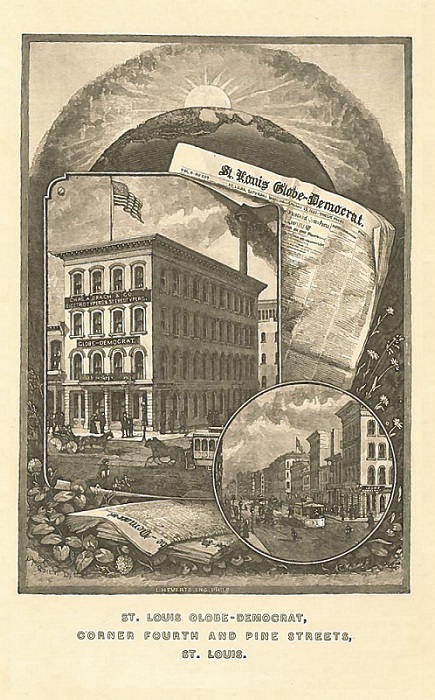 In its early days The Globe-Democrat was a formidable force for the Union, the only major pro-Union newspaper in a slave or border state.
In its early days The Globe-Democrat was a formidable force for the Union, the only major pro-Union newspaper in a slave or border state.
It was significantly instrumental in keeping Missouri within the Union and President Lincoln said of The Globe-Democrat that it was worth 10 regiments of Union troops.
It pioneered the use of telegraph in gathering news.
In those days its editors survived personal attacks and the newspaper offices were the target of mobs on several occasions as the newspaper fought for the Union cause in generally pro-Southern Missouri.
In post Civil War America, The Daily Missouri Democrat prospered and became the most significant channel of information between Congress and the developing West and Southwest.
It regularly printed special correspondent reports from all states bordering Missouri and paid special attention to events in states far out of its general circulation area such as Texas.
About that time the newspaper began to give its readers regular cable reports from Europe and strengthened its local news coverage, a mark that has distinguished the newspaper to the present day.
By May of 1875, the original Democrat had become The Globe-Democrat, when two of its three partners who had been forced out of the Democrat in a dispute formed The Globe, repurchased the Democrat and merged the two papers.
The newspaper entered one of its most productive and successful eras under the editorship of Joseph B. McCullagh, an Irish immigrant who had trained as a cub reporter with the Democrat in the early 1850s.
McCullagh was famous for short, pithy writing and for pioneering the technique of interviewing public officials that led to today’s press conference.
He broadened the newspaper’s national and regional coverage and by 1892 was spending the almost incredible sum of $400,000 annually for telegraphed news.
But he continued to stress local news coverage.
“Little Mac,” as he had been affectionately dubbed, was the object of a laudatory poem by St. Louis poet Eugene Field and was highly regarded in newspaper opinion throughout America.
If a story had violence or sex, was different or sensational or dealt with the odd and mystical, he printed it almost without regard to where it happened.
At his death in 1896 The Globe-Democrat was one of the nation’s leading daily newspapers and was financially prosperous despite its high news-gathering budget.
McCullagh was succeeded by the newspaper’s principal political writer, Captain Henry King, who maintained its pattern of success until his death in 1915.
King was a highly talented writer in addition to being a vigorous editor in covering news.
He believed that what was best for business interests was best for the common good of the community.
The principal stories of this era were the Spanish-American War and the Louisiana Purchase Centennial Exposition (The St. Louis World’s Fair of 1904).
King and The Globe-Democrat business manager Daniel M. Houser, who was a famous business office newspaperman, often paid as high as $1.50 a word for cable dispatches in their coverage of the Spanish-American War.
In its May 1, 1904 Sunday edition The Globe-Democrat told its readers of the opening of the famous World’s Fair the previous day. The edition was almost entirely devoted to the fair.
The entire top half of page one presented a photograph of the Plaza of St. Louis at the fairgrounds at Forest Park and the newspaper estimated that 232,000 persons were present.
President Theodore Roosevelt officially opened the exposition from Washington, D.C. by touching a telegraph key that set in motion the unfurling of flags and banners from turrets, cupolas and towers in the “ivory city” that was the fairgrounds.
The Globe-Democrat called it a “Special Soldiers, Sailors and Marine Edition,” and said it was the first of its kind.
Soon the idea was being copied by other metropolitan newspapers in America.
The newspaper did not make the mistake of many papers, including two St. Louis dallies, of printing on Thursday, Nov. 7, 1918, the signing of the “false armistice.”
In its “extra final” edition it reported that Berlin “was said” to have accepted the armistice.
The “Armistice” did not actually begin until four days later.
It was during the Ray stewardship that the Globe-Democrat won over its morning rival “The Republic,” marking the end of one of the most bitter feuds in American newspaper history.
Notable among the newspaper’s development in the coming years was its financial support of Charles A. Lindbergh in his famous flight across the Atlantic; its emergence from an isolationist stance during World War I into an internationalist stance preceding, during and after World War II, and the winning of its first Pulitzer Prize by editorial writer Louis LaCoss for his famous 1951 editorial, “The Love Estate of Public Morals.”
It also presented various promotions such as the Golden Gloves and the annual choral pageants.
One of the newspaper’s most famous editors, Joseph J. McAuliffe, directed the newspaper from the time of King’s death until the beginning of World War II. He was succeeded by another editor of note, Lon M. Burrowes.
McAuliffe was a noted political prognosticator in addition to being a nationally known editor and from 1910 to 1940 he missed on predicting only two presidential elections and guessed wrong on the Missouri governorship races only once.
A colleague of McAuliffe on the Globe-Democrat was Casper S. Yost, former Sunday editor who had taken over the editorial page.
It was Yost who had revealed the baffling story of Patience Worth when he was Sunday editor.
Patience Worth was said to be a 17th century Englishwoman who communicated poems and novels through the person of Mrs. John Curran, a St. Louis housewife, and the medium of a Ouija board.
Doctors, scientists, authors and reporters from all parts of the nation came to St. Louis to investigate the phenomenon.
It began in 1913 as Mrs. Curran and a friend sat at the Ouija board and the board spelled out Patience Worth’s quaintly worded messages, stories and poems, letter by letter.
The story sold Ouija boards all across the nation and many people believed a deceased person was actually writing through Mrs. Curran and the Ouija board. Among them was the famous writer and critic William Marion Reedy, editor of Reedy’s Mirror, who started out as a skeptic and ended as a “true believer.”
Yost told the entire story in a book, “Patience Worth, a Psychic Mystery,” which the Atlantic Monthly favorably reviewed.
Yost had been a major contributor to a national code of newspaper ethics that delineated the boundaries of good taste and morals within which good newspapermen and their papers should function.
During the “Roaring Twenties” (they were also called the “flush twenties” in St. Louis) and the following depression years, the Globe-Democrat recorded America’s “La Dolce Vita,” when life was lived on stock and moral margins and the subsequent collapse when much of life centered on bread lines.
In between the great wars the newspaper also told its readers of the glorious triumph by the 1926 baseball Cardinals, a sensational and highly partisan story which required so much space to tell that it nearly forced the annual Veiled Prophet Parade out of the newspaper; the Lindy flight and the world’s response to that heroic deed; the terrible 1927 tornado that struck central and north St. Louis; the end of prohibition in 1933 and the ominous sabre rattling of Hitler and the Japanese.
The sabre was finally thrust at America.
The edition was dated Monday morning, December 8, 1941.
In its Final Extra edition bearing a three deck headline in the bolds of black lettering, the Globe-Democrat subscriber read:
“CONGRESS CALLED TO MEET WAR DECLARATION OF JAPAN: HUNDREDS ARE KILLED IN ATTACK ON HAWAII”
It was too early to judge the devastation at Pearl Harbor, there was too much confusion, broken communication, fear and misinformation.
The Associated Press lead story began simply:
WASHINGTON, December 8 (Monday) – Bombs from Japan made war on the United States yesterday and as the death tolls mounted…”
In what appeared to be an overstatement at the moment a sail headline read: “Japanese Communique Declares Attack on Oahu ‘Great Success.’”
For four years the story of the great war took up residence on page one.
It was not until Aug. 15, 1945, as Japan surrendered that the Globe-Democrat could boldly proclaim: “WAR ENDS, JAPAN ACCEPTS.”
Post-war America was to produce world shaking news that kept the headline writers alert.
Beginning with the Truman upset victory in 1948, Globe-Democrat stories and banner headlines dealt with such tremendous developments as the Korean War, atomic power (earlier headlined on Aug. 7, 1945 with the dropping of the first atomic bomb on Hiroshima). The Salk polio vaccine, Eisenhower’s political victories, Russian Sputniks, the Kennedy election, the Kennedy assassination, Vietnam, men walking on the moon, the Nixon victories and Watergate and the humiliating resignation of both President Richard M. Nixon and his vice president Spiro Agnew, and the election of Jimmy Carter.
It was a breathtaking era of monumental news stories.
Watergate was a story and it was told fully.
The Globe-Democrat was able to give its readers the entire Washington Post expose because it subscribes to the Washington Post news service.
The columns of space devoted to the Watergate story ran into the hundreds and in addition more than 20 full pages of tape transcriptions of the incriminating presidential conversations were printed verbatim.
In post-war America, The Globe-Democrat was to become a late entry into the collateral communications field of radio and television.
The newspaper built an elaborate FM radio studio at 12th and Cole streets that was later converted to television use as the newspaper obtained major interest in KWK-TV.
Eventually S. I. Newhouse, through his television corporation, obtained full ownership of KTVI (Channel 2).
The radio station was built to honor the memory of E. Lansing Ray’s son, E. Lansing Jr., who died of a cerebral hemorrhage in 1946 after he returned from service where he had suffered an injury.
With his son’s passing the elder Ray had lost the chance to realize his dream, the transfer of the Globe-Democrat to his son, who in the prewar days had worked in several of the newspaper’s departments and was preparing to assume its leadership.
In the early fifties Mr. Ray was getting up in years and lacking an heir to take over, decided to sell his newspaper.
in 1955 S.I. Newhouse purchased the Globe-Democrat and, after E. Lansing Ray’s death five months later, installed a dynamic journalist, Richard H. Amberg as its publisher and an experienced newsman, Charles E. Pierson, as its executive editor.
Both Amberg and Pierson are deceased.
In the twenty two years since Newhouse published the paper, the Globe-Democrat has achieved many successes, won numerous awards and under its present publisher, G. Duncan Bauman, a veteran newsman and lawyer, has achieved circulation leadership in the daily field.
The paper won its second Pulitzer Prize in 1969 for exposing corruption in the Pipefitters union.
It was honored with several awards and won national honors for exposing arson for profit, traffic court corruption, highway safety perils and for outstanding reporting of government news.
Its present city editor, Sue Ann Wood, wrote stories that helped win the Albert Sloan award, given to the newspaper judged to have done the most for highway safety in the nation.
It has also been honored for special coverage of NAACP activities and for excellence in medical journalism.
And, beginning in 1969 and lasting for several years, Globe-Democrat reporters exposed widespread graft and political corruption in the East Side Levee and Sanitary District and the East St. Louis School District.
Much of the information they gathered helped the federal grand juries that handed down more than 20 indictments against levee and school board officials, most of whom were convicted in later trials.
The Globe-Democrat also fought and helped win a years-long battle to retain Lambert St. Louis International Airport as the area’s major airport instead of constructing a billion-dollar new airport in the Columbia-Waterloo vicinity in Illinois.
In 1956 two of The Globe’s ablest reporters, Carl Major (now retired) and Ray J. Noonan (now assistant managing editor) found huge state cash deposits in favored banks where they were doing little for the taxpayers.
Their “Idle Funds” series changed state investment procedures and by 1976 more than $156 million had been earned for taxpayers as a result of their disclosures.
Since the mid-Fifties, The Globe-Democrat has promoted numerous successful community interest activities, including the impressive, socially responsible promotion, “Old Newsboys’ Day.”
In its 20 years of existence the annual “Old Newsboys’ Day” has produced $1.6 million for numerous charity organizations.
The Globe-Democrat pays the entire cost of a special “Old Newsboys’ Day” edition sold by volunteers on street corners Wednesday before Thanksgiving.
Among the newspaper’s other successful promotions is the “Newspaper in Education” program that provides the daily paper as a teaching tool in hundreds of area schools and encourages the development of pupil reading skills.
The Globe-Democrat today is produced by means that provide contrast with the methods of a scant five years ago.
Its reporters are starting to type their stories on electronic Video Display Terminal machines instead of typewriters, and in the Post-Dispatch composing room (where the Globe-Democrat is printed under contract) electronic tape operators and computers now do the work formerly performed by Linotype operators and hand-set printers.
Its new makeup gives the reader more words to the line (increased from four or five to seven) by providing fewer and wider columns.
New flexibility with type enables editors to “package” stories so that major news events can be presented compactly and with more emphasis and detail.
And the new makeup provides less crowding of the news and therefore less distraction to the reader, although the number and quality of stories has not decreased.
Years of chronicling
As the Globe-Democrat enters its 126th year some of the news page content has changed. There is more emphasis on special sports, personalities and on columns of expert advice to help people to live in today’s fast moving world. The newspaper will continue to pioneer the new art of packaging and displaying news to attract the reader of the last of the 20th Century.
And it can look back over 125 years of chronicling the important news and of a continuous flow of dedicated editors, publishers and reporters who established and maintained its quality as a major contributor to the knowledge and life of its readers.
By William Feustel 7/1/1977
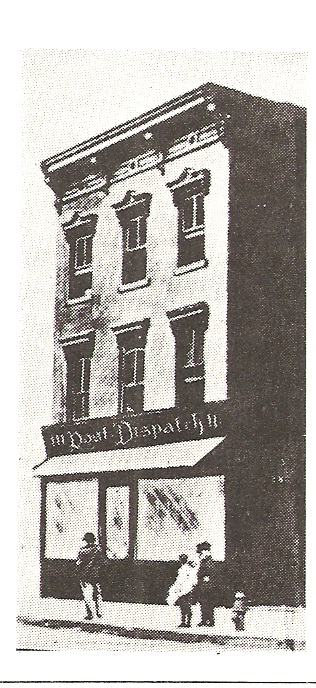
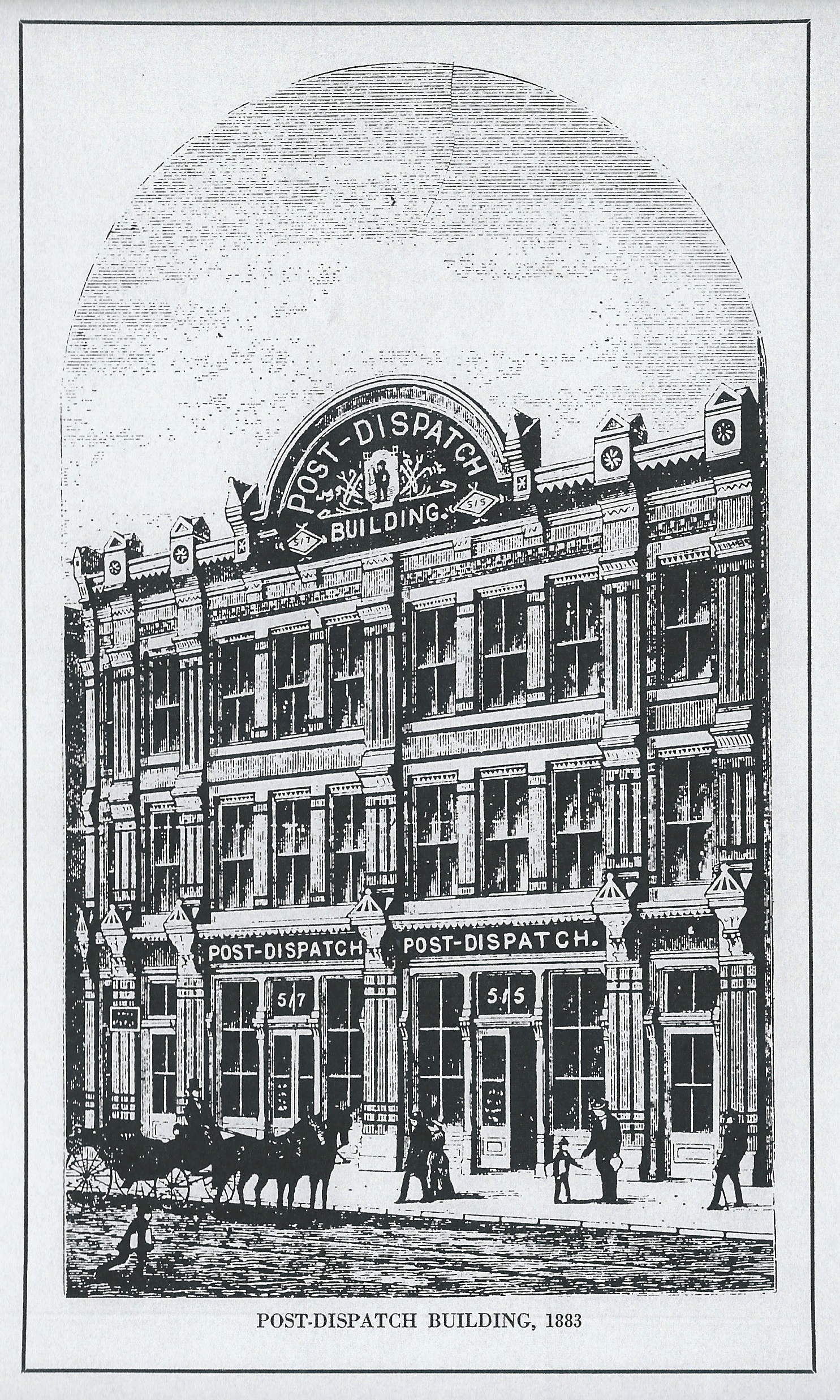

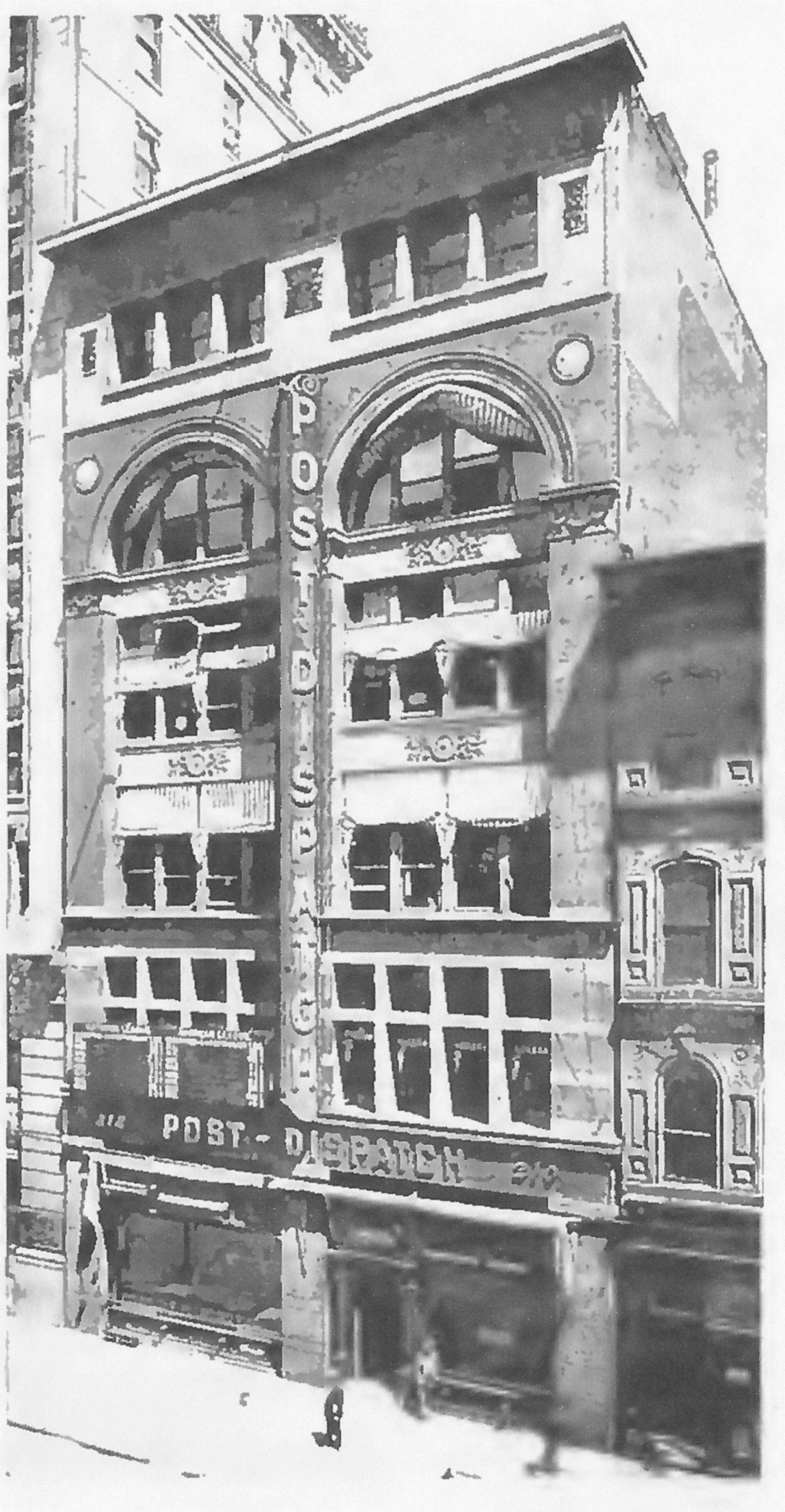
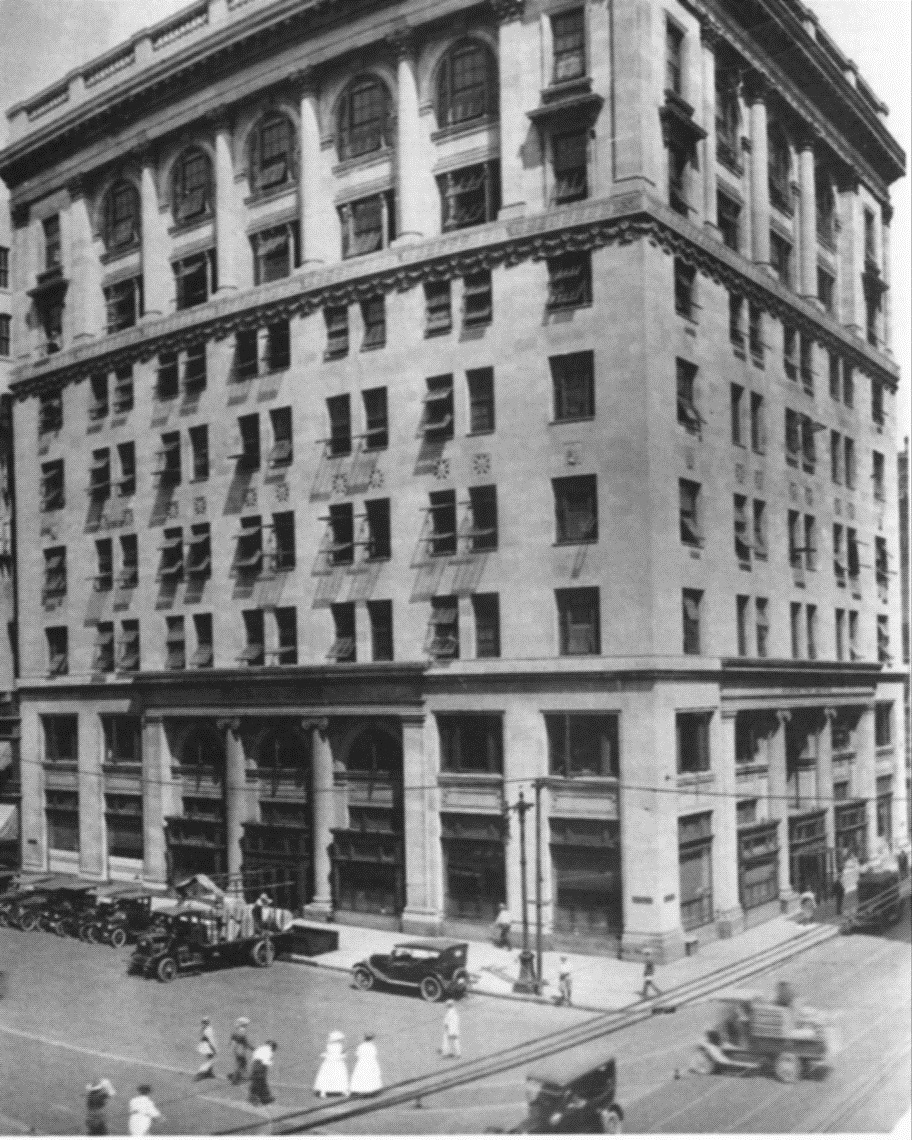
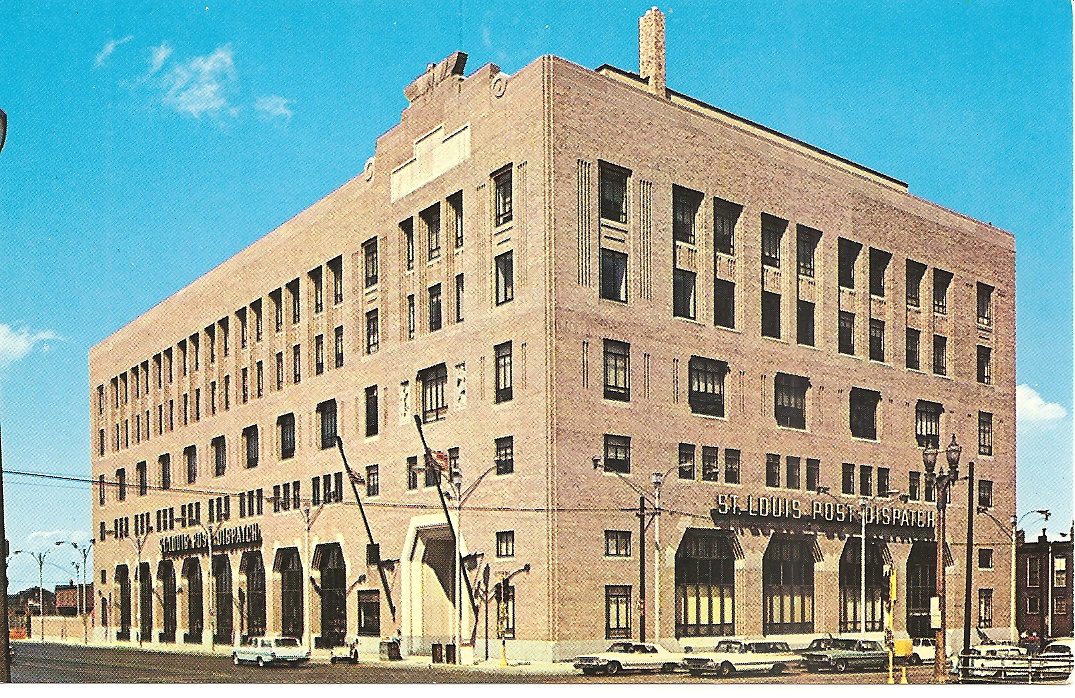
 In its early days The Globe-Democrat was a formidable force for the Union, the only major pro-Union newspaper in a slave or border state.
In its early days The Globe-Democrat was a formidable force for the Union, the only major pro-Union newspaper in a slave or border state.